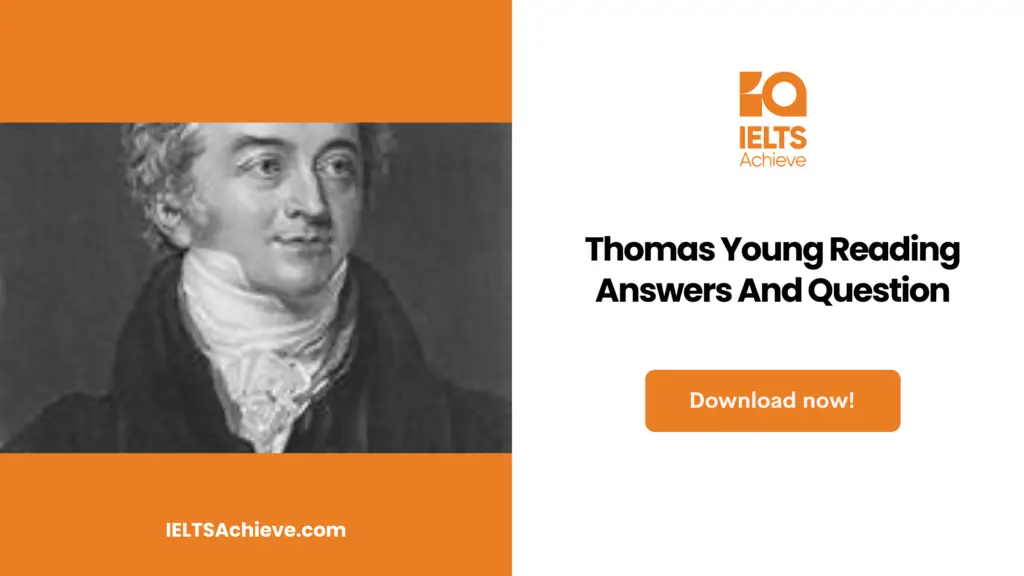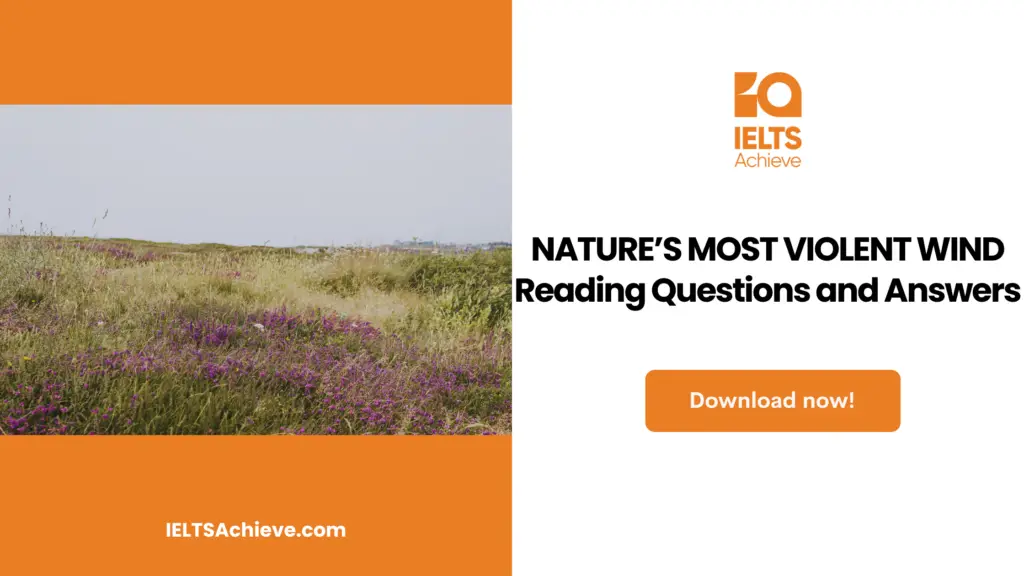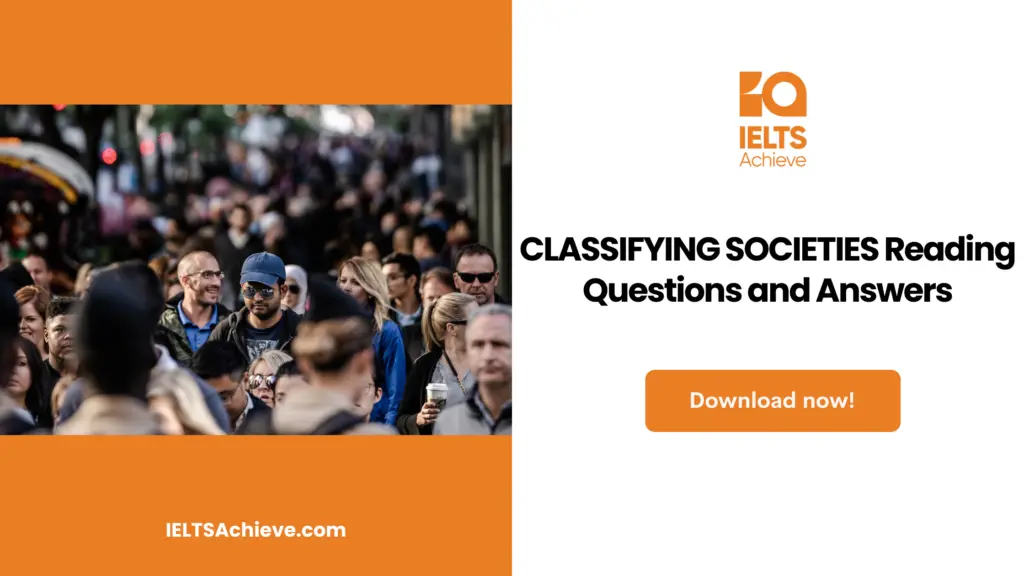The Blog post contains the following IELTS Reading Questions:
- IELTS Reading True/False/Not Given
- IELTS Reading Short Answer Questions
- IELTS Reading Multiple Choice Questions
Stay informed and prepared for success – Explore our comprehensive Reading Test Info page to get valuable insights, exam format details, and expert tips for mastering the IELTS Reading section.
IELTS reading passage – Thomas Young

Thomas Young
The Last True Know-It-AU
Thomas Young (1773–1829) wrote 63 articles for the Encyclopedia Britannica, including 46 biographies (primarily of scientists and classicists) and in-depth pieces on “Bridge,” “Chromatics,” “Egypt,” “Languages,” and “Tides.” Was someone a polymath, a genius, or a dilettante if they could write with authority on so many subjects? According to Andrew Robinson’s ambitious new biography, Young is a strong candidate for the title “the last man who knew everything.” Young faces opposition, though: The term, which Robinson adopts as his subtitle, also appears in two other recent biographies: Paula Findlen’s 2004 biography of polymath Athanasius Kircher (1602-1680) and Leonard Warren’s 1998 biography of palaeontologist Joseph Leidy (1823-1891).
Of course, Young produced more than just encyclopedia entries. At the age of 20, he delivered his first paper to the Royal Society of London, and a week after being 21, he was elected a Fellow. Young described how the human eye accommodates, or how the eye can focus correctly on objects at various distances, in the study. Young claimed that adjustments to the lens’s shape were liable for this. Young also proposed the wave theory of light, and he felt that there must be three receptors in the eye that correspond to the three “primary colours” to which the retina may respond: red, green, and violet, in order to explain the ability to see in colour. All of these hypotheses were later shown to be true.
Later in life, in his forties, Young played a key role in decoding the code that opened the mysterious script on the Rosetta Stone, a tablet that perhaps the Napoleonic army “discovered” in Egypt in 1799. The text on the stone is written in three different alphabets: Greek, an unknown alphabet, and Egyptian hieroglyphs. Young surmised that the obscure writing, now known as demotic, is intimately related to hieroglyphic. His initial research on this was included in his entry on Egypt in the Britannica. He first used the term Indo-European to refer to the family of languages that are spoken across the majority of Europe and northern India in another entry. These are the ground-breaking accomplishments of a man who was a child prodigy and who, in contrast to many other gifted kids, did not fade into obscurity as an adult.
Young, who was born in 1773 and raised with his maternal grandparents in Somerset, England, finally moved out to pursue boarding school. He had been a bookworm since he was two years old, and on his own initiative, he became an expert in Latin, Greek, mathematics, and natural philosophy. Richard Brocklesby, a doctor and Fellow of the Royal Society, was his mother’s uncle, and he gave him a lot of encouragement after he finished school. Young made the decision to pursue a career in medicine after Brocklesby. Following the medical tour, he studied in London before continuing on to more formal studies in Edinburgh, Gottingen, and Cambridge. Young opened a medical practice in London in 1808 after finishing his medical background at the University of Cambridge. Soon after, he was admitted to the Royal College of Physicians and sent to St. George’s Hospital as a physician.
But Young’s talent as a doctor fell short of his skill as a student of languages or natural philosophy. At the Royal Institution, where he held a professorship of natural philosophy before, he gave up to 60 lectures a year beginning in 1801. These were released in 1807 in two volumes. Young was appointed secretary of the Royal Society in 1804 and remained in that position until his passing. On civic and national issues, such as the implementation of gas lighting in London and shipbuilding techniques, his thoughts were sought after. He served as the Nautical Almanac’s superintendent and Board of Longitude secretary beginning in 1819. He served as the Palladian Insurance Company’s doctor and calculations inspector from 1824 until 1829. He provided his extensive and varied entries to the Encyclopedia Britannica between 1816 and 1825, and over the course of his career, he wrote a great deal of books, essays, and papers.
Young is the ideal, yet intimidating, subject for a biography. Few men made as much of an impact in so many technical domains. Robinson wants to explain Young’s work and life to non-scientists. He succeeds in delivering the technical material in a clear manner (especially on optics and Egyptian hieroglyphs). Young’s accomplishments will strike some readers of this book as impressive, like Robinson, while others will view him as a dilettante like some historians have. However, despite the wealth of information in this book, readers won’t get to know Young personally. A lighthearted Young can be seen writing Latin and Greek words in his notes for medical courses and translating the lines that a young woman had scrawled on a summerhouse’s walls into Greek elegiacs. Young was introduced to high society, went to the theatre, and managed to pick up dancing and flute playing. Additionally, he was a skilled rider. But in comparison to his dynamic profession and studies, his personal life seems tepid.
According to Robinson, Young married Eliza Maxwell in 1804, and “their marriage was a happy one and she appreciated his work.” The only things we really know about her are that she supported her husband through some contentious arguments about optics and that she fretted about money when his medical profession didn’t take off right away. The complexity of Young’s connections with his mother and father are little documented. Robinson does not attribute Young’s remarkable thinking to them or anybody else. Despite the paucity of information regarding Young’s relationships, this book is recommended for anyone curious about what it means to be a genius.
Unlock your full potential in the IELTS Reading section – Visit our IELTS Reading Practice Question Answer page now!
Recommended Questions:
Renewable Energy IELTS Reading Question with Answer
Thomas Young Reading Questions
Questions 1-6
Do the following statements agree with the information given in the reading passage? In boxes 1-6 on your answer sheet, write
TRUE if the statement is true
FALSE if the statement is false
NOT GIVEN if the information is not given in the passage
- Each of Young’s articles appeared in Encyclopedia Britannica.
- Others have also raised a claim to “the last man who knew everything.”
- Young’s abilities as a physician far overshadowed his other abilities.
- Young, like many others, struggled academically as a young person.
- People with responsibility for local and international issues sought Young’s advice.
- Young had suffered from a disease in his old age.
Enhance your skills in identifying information as True, False, or Not Given. Click here to discover expert strategies and techniques for mastering this question type in the IELTS Reading section.
Questions 7-10
Choose NO MORE THAN THREE WORDS AND/OR A NUMBER from the passage for each answer.
7. How many biographies for the Encyclopedia Britannica did Young pen?
8. In his initial academic publication, Young focused on what area of scientific study?
9. What name did Young coin to describe a group of languages?
10. Who gave Young the motivation to begin his medical studies?
Questions 11-13
11. Which pathways did Young choose after school?
- Technology
- Medicine
- Visual arts
- None of the above
12. In whose opinion was Young capable enough for the title “the last man who knew everything”?
- Rosetta
- Richard
- Robinson
- Maxwell
13. Which of the following hasYoung NOT claimed in his academics?
- How human eye focus
- that modifications of the lens were to blame
- Theory of colours and eye receptors
- That reflex action can be controlled
Ready to improve your performance in Multiple Choice Questions (MCQs)? Click here to access our comprehensive guide on how to tackle MCQs effectively in the IELTS Reading section.
Unlock your full potential in the IELTS Reading section – Visit our IELTS Reading Practice Question Answer page now!
Recommended Questions:
Renewable Energy IELTS Reading Question with Answer
Thomas Young Reading answers
1. FALSE
2. TRUE
3. NOT GIVEN
4. FALSE
5. TRUE
6. NOT GIVEN
7. 46
8. Human eye accommodation
9. Indo-European
10. Richard Brocklesby
11. B
12. C
13. D

We hope you found this post useful in helping you to study for the IELTS Test. If you have any questions please let us know in the comments below or on the Facebook page.
The best way to keep up to date with posts like this is to like us on Facebook, then follow us on Instagram and Pinterest. If you need help preparing for the IELTS Test, join the IELTS Achieve Academy and see how we can assist you to achieve your desired band score. We offer an essay correction service, mock exams and online courses.

